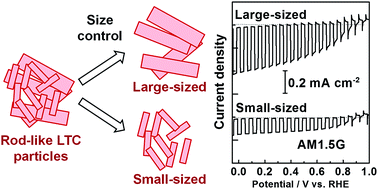Effect of particle size of La5Ti2CuS5O7 on photoelectrochemical properties in solar hydrogen evolution†
Abstract
La5Ti2CuS5O7 (LTC) is an oxysulphide semiconductor with spatially separated one-dimensional carrier transport properties that are applicable to sunlight-driven photoelectrochemical (PEC) water splitting. In this study, rod-like LTC particles with different sizes were prepared by controlling the annealing duration and sequential centrifugation conditions, and their PEC properties were investigated to develop a material design strategy tailored for hydrogen evolution. The larger LTC particles were found to generate a higher photocurrent. The hypothetical half-cell solar-to-hydrogen energy conversion efficiency of Mg-doped LTC reached 0.17% at 0.6 V vs. RHE. The faradic efficiency of the PEC hydrogen evolution was also confirmed to exceed 90%. Scanning electron microscopy images of PEC-deposited Pt nanoparticles showed that they were selectively loaded on the edge surface of large LTC particles, while they were loaded on both the lateral and edge surfaces of small LTC particles. This is presumably because the large LTC particles contained lower densities of defects and grain boundaries, interrupting the spatially separated carrier transport. Therefore, the use of well-grown, rod-like LTC particles is concluded to be favourable for PEC hydrogen production.


 Please wait while we load your content...
Please wait while we load your content...